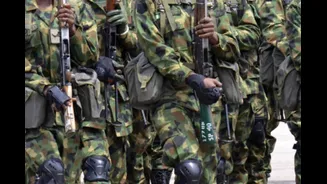A 10-day Indian tri-services exercise along the western frontier has reportedly set alarm bells ringing in Pakistan, with Islamabad said to have put multiple commands and bases on high alert, CNN-News18
has learnt.
India issued a Notice to Airmen (NOTAM) for combined Army-Navy-Air Force manoeuvres reportedly running from October 30 to November 10, focused along the Sir Creek-Sindh-Karachi axis—an area Pakistani sources describe as the “deep south” of Pakistan. Sources told CNN-News18 that the exercise’s geographic emphasis and timing have prompted Islamabad to heighten vigilance across southern commands, where the military is allegedly “in panic” over potential contingency scenarios.
A top Pakistani security source said the country has issued high alerts for Southern Commands in Sindh and South Punjab, mobilising the Air Force and Navy on stand-by to respond to any perceived aggression. Pakistan’s Bahawalpur Strike Corps and Karachi (Sindh) Corps were specifically singled out for special preparedness measures, the source said. Air bases reportedly put on standby include Shorkot, Bahawalpur, Rahim Yar Khan, Jacobabad, Bholari and Karachi; naval directives have also been issued to increase patrolling and operations in the Arabian Sea, the source added.
The intelligence picture is said to show India choosing southern sectors—from Bahawalpur and Rahim Yar Khan to the Thar Desert and the Sir Creek area—so as to test joint naval-air-land coordination. Pakistan officials quoted by sources fear the drills could be used to demonstrate capability to threaten maritime chokepoints and coastal infrastructure that feed into Karachi—Pakistan’s economic heart. Nearly 70 per cent of Pakistan’s trade reportedly passes through Karachi Port and Bin Qasim, making those facilities strategically sensitive.
The sources added that India’s southern focus is designed to send a clear message: The country can open multiple fronts, not just in Punjab or Kashmir.
They said the Sir Creek-Badin-Karachi belt is among Pakistan’s weakest military sectors: relatively flat, lightly defended, and logistically exposed. The concern, they say, is that any successful strike or extended operation there could isolate Karachi and disrupt Pakistan’s maritime trade and energy supplies.
The situation is compounded, according to the same sources, by internal security pressures: Pakistan’s Army is already stretched by militant activity in the Khyber-Peshawar belt, giving rise to fears that simultaneous external pressure could strain resources further.
India’s defence ministry, however, describes such NOTAM-defined exercises as routine preparedness measures. Indian officials typically stress that training along international borders is standard practice to validate joint operational readiness.
For now, Pakistani commands remain on heightened alert as both sides continue to monitor movements along the western maritime and land approaches. Sources say the episode underscores how military signalling through large-scale exercises can produce acute political and strategic anxiety across borders, even if the activity is framed as routine training.















